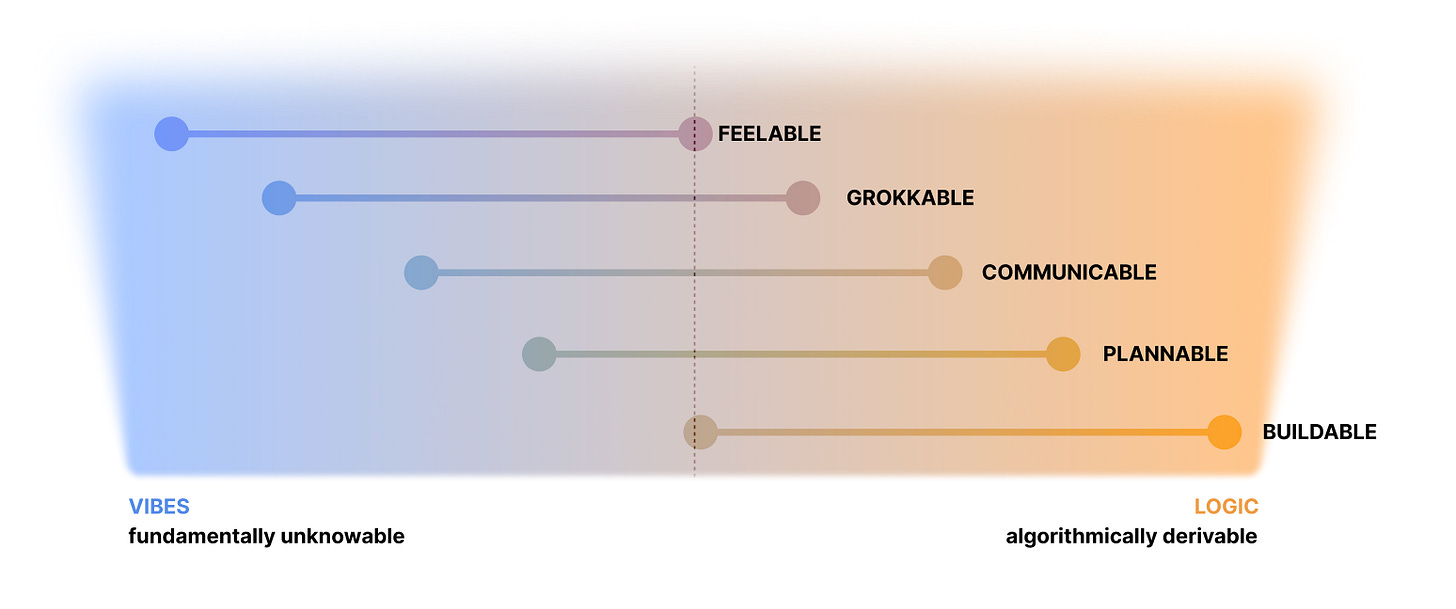The Ambiguity Spectrum
Does your brain break, or bend?

In my “career” thus far, I’ve noticed that my colleagues and myself fall on a spectrum somewhere between depending on constraints to rejecting them altogether. People seem to have a “tolerance for ambiguity” that confines them to some region along this spectrum.
Visionary/artistic work sits at the left (high-ambiguity, low-constraint) then engineering and specification work at the right (low-ambiguity, high-constraint); research & design occupy the center, playing with and shaping constraints.
Work roles are typically defined by skill or industrial focus, but I would argue “tolerance for ambiguity” is a fundamental axis for understanding fit and satisfaction within a team.
Based on my experience, your position on and “spread” across this spectrum is partly innate, partly trainable. There are limits to how much you can expand it but you can go surprisingly far. In fact, my particular development has been that I could work at either end of the spectrum but couldn’t smoothly transition through the center… Which likely explains the increasing ‘design’ focus to my work over the years, transitioning from ‘artist and engineer’ to a ‘full-stack creative’1.
My interest in game development forced me to traverse the whole spectrum, from pure vision to hard engineering. I believe something similar is true for professional artists, solo creatives, small teams and entrepreneurs generally. My diagram implies that philosophy and game development both demand this spread, which may seem surprising but if you’ve read my writing… perhaps less so.
In theory, People who love constraints will struggle in open-ended, ambiguous work; people who resist constraints will struggle in rigid, systematized environments… but that’s a static picture, not a dynamic one.

In design, the diverge-converge diamond (as shown above) is an example of deliberately moving around the ambiguity spectrum.
Creative work must proceed from vibes towards logic to produce tangible results, but, the path is non-linear. You need to skip back, or even jump back to the drawing board.
That creative journey is a mirror of life itself. We’re forced to move between regions of ambiguity, often without choice, with an unclear progression; our adaptability is often more important than niche specialization2. Learning from experience in one’s own life is a creative exercise and the ability to switch modes and engage with ambiguity in different ways is a key skill that can gate your progress in any domain, not just design.
Human cognition’s superpower is to hold contradictions3, to entertain multiple possibilities and frameworks at once. This is the root of creativity and adaptability: to hold back from certainty.
Navigating reality via metaphor and analogy strikes me as the key to a malleable consciousness - capable of operating in an unstable hyper-reality (such as our own).
Rendering the unknown in terms of the known—through fantasy, concept work, or analogy—is the core act of navigating ambiguity.
This model also explains why the frontier-work of creativity is often a solo-endeavour. Before something is broadly communicable we need to remove most of the ambiguity! Before that stage, only people with shared experience and perspective will ‘grok’4 the idea, and that is your creative community.

One thing I am grateful for in my life is to have worked with multiple people who can actually join me at the ‘vibes’ stage of the process. Shoutout to you all, you probably know who you are.
Communicating multifaceted, ambiguous, and context-rich ideas is an art: it requires empathy, metacognition, and the ability to build shared context with a stranger.
(This is more of a freeform, single-session post. Hopefully the looseness is appreciated!)
✌️ Ben
Stuff I’ve been thinking about
Hmm… seems like a theme. I would love to write the post: “how to use ambiguity and metaphor to unlock humanistic value from AI”… maybe soon.
A complex mental refactoring that involved dismantling ego, letting go of static identity and standing everywhere
Without wasting too many words on it, this is basically Simulated Annealing or ‘evolution’ in general
I want to keep using this word in spite of the brand connections, but the collision is annoying for me too




I’m not sure if you’re aware of Iain McGilchrist’s work on the two brain hemispheres but this is essentially the same thing! And I’m currently writing a book where the basic theme is that all processes in the world (what I’m calling the universal metapattern) is essentially when you go from vibes —> logic —> vibes again. Great article.